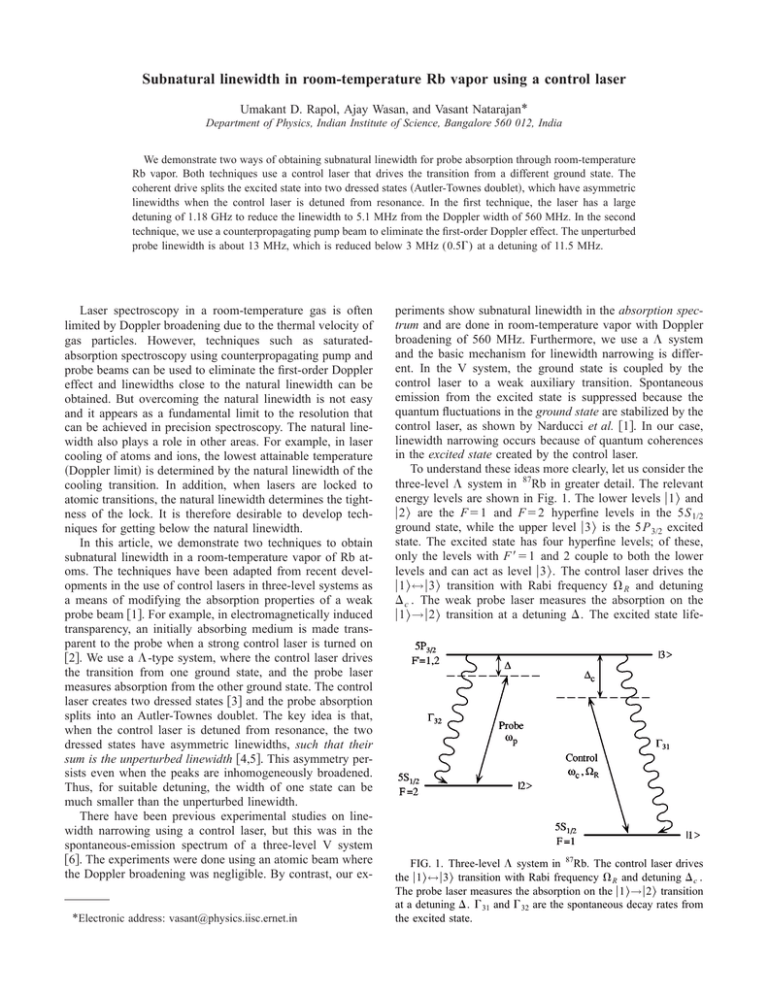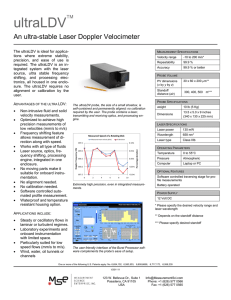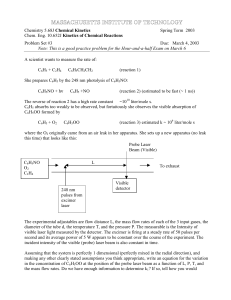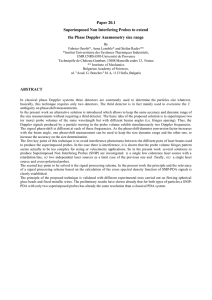Subnatural linewidth in room-temperature Rb vapor using a control laser *
advertisement

Subnatural linewidth in room-temperature Rb vapor using a control laser Umakant D. Rapol, Ajay Wasan, and Vasant Natarajan* Department of Physics, Indian Institute of Science, Bangalore 560 012, India We demonstrate two ways of obtaining subnatural linewidth for probe absorption through room-temperature Rb vapor. Both techniques use a control laser that drives the transition from a different ground state. The coherent drive splits the excited state into two dressed states 共Autler-Townes doublet兲, which have asymmetric linewidths when the control laser is detuned from resonance. In the first technique, the laser has a large detuning of 1.18 GHz to reduce the linewidth to 5.1 MHz from the Doppler width of 560 MHz. In the second technique, we use a counterpropagating pump beam to eliminate the first-order Doppler effect. The unperturbed probe linewidth is about 13 MHz, which is reduced below 3 MHz (0.5⌫) at a detuning of 11.5 MHz. Laser spectroscopy in a room-temperature gas is often limited by Doppler broadening due to the thermal velocity of gas particles. However, techniques such as saturatedabsorption spectroscopy using counterpropagating pump and probe beams can be used to eliminate the first-order Doppler effect and linewidths close to the natural linewidth can be obtained. But overcoming the natural linewidth is not easy and it appears as a fundamental limit to the resolution that can be achieved in precision spectroscopy. The natural linewidth also plays a role in other areas. For example, in laser cooling of atoms and ions, the lowest attainable temperature 共Doppler limit兲 is determined by the natural linewidth of the cooling transition. In addition, when lasers are locked to atomic transitions, the natural linewidth determines the tightness of the lock. It is therefore desirable to develop techniques for getting below the natural linewidth. In this article, we demonstrate two techniques to obtain subnatural linewidth in a room-temperature vapor of Rb atoms. The techniques have been adapted from recent developments in the use of control lasers in three-level systems as a means of modifying the absorption properties of a weak probe beam 关1兴. For example, in electromagnetically induced transparency, an initially absorbing medium is made transparent to the probe when a strong control laser is turned on 关2兴. We use a ⌳-type system, where the control laser drives the transition from one ground state, and the probe laser measures absorption from the other ground state. The control laser creates two dressed states 关3兴 and the probe absorption splits into an Autler-Townes doublet. The key idea is that, when the control laser is detuned from resonance, the two dressed states have asymmetric linewidths, such that their sum is the unperturbed linewidth 关4,5兴. This asymmetry persists even when the peaks are inhomogeneously broadened. Thus, for suitable detuning, the width of one state can be much smaller than the unperturbed linewidth. There have been previous experimental studies on linewidth narrowing using a control laser, but this was in the spontaneous-emission spectrum of a three-level V system 关6兴. The experiments were done using an atomic beam where the Doppler broadening was negligible. By contrast, our ex- *Electronic address: vasant@physics.iisc.ernet.in periments show subnatural linewidth in the absorption spectrum and are done in room-temperature vapor with Doppler broadening of 560 MHz. Furthermore, we use a ⌳ system and the basic mechanism for linewidth narrowing is different. In the V system, the ground state is coupled by the control laser to a weak auxiliary transition. Spontaneous emission from the excited state is suppressed because the quantum fluctuations in the ground state are stabilized by the control laser, as shown by Narducci et al. 关1兴. In our case, linewidth narrowing occurs because of quantum coherences in the excited state created by the control laser. To understand these ideas more clearly, let us consider the three-level ⌳ system in 87Rb in greater detail. The relevant energy levels are shown in Fig. 1. The lower levels 兩 1 典 and 兩 2 典 are the F⫽1 and F⫽2 hyperfine levels in the 5S 1/2 ground state, while the upper level 兩 3 典 is the 5 P 3/2 excited state. The excited state has four hyperfine levels; of these, only the levels with F ⬘ ⫽1 and 2 couple to both the lower levels and can act as level 兩 3 典 . The control laser drives the 兩 1 典 ↔ 兩 3 典 transition with Rabi frequency ⍀ R and detuning ⌬ c . The weak probe laser measures the absorption on the 兩 1 典 → 兩 2 典 transition at a detuning ⌬. The excited state life- FIG. 1. Three-level ⌳ system in 87Rb. The control laser drives the 兩 1 典 ↔ 兩 3 典 transition with Rabi frequency ⍀ R and detuning ⌬ c . The probe laser measures the absorption on the 兩 1 典 → 兩 2 典 transition at a detuning ⌬. ⌫ 31 and ⌫ 32 are the spontaneous decay rates from the excited state. time is 26 ns, and therefore the spontaneous decay rates ⌫ 31 and ⌫ 32 are both equal to 2 ⫻6.1 MHz. The absorption of the weak probe in the ⌳ system has been derived previously 关4兴. As is well known, the control laser splits the upper level into two dressed states due to the ac Stark shift. The probe absorption gets modified due to this and shows peaks at the location of the two dressed states 共Autler-Townes doublet兲, given by ⌬ ⫾⫽ ⌬c 1 ⫾ 冑⌬ 2c ⫹⍀ R2 . 2 2 共1兲 Here ⌬ ⫹ and ⌬ ⫺ are the values of the probe detuning where the peaks occur. The corresponding linewidths (⌫ ⫾ ) of these peaks are different because of the coherence between the two dressed states, and given by ⌫ ⫾⫽ 冉 冊 ⌫ 31⫹⌫ 32 ⌬c 1⫿ . 2 4 冑⌬ c ⫹⍀ R2 共2兲 It is clear from the above expression that, if ⌬ c ⫽0, the two peaks are symmetric and have identical linewidths of (⌫ 31⫹⌫ 32)/4. However, for any nonzero detuning, the peaks have asymmetric linewidths. The first peak has larger linewidth while the second peak has smaller linewidth by precisely the same factor, in such a way that the sum of the two linewidths is equal to the unperturbed linewidth (⌫ 31⫹⌫ 32)/2. The above analysis is for a stationary atom. If the atom is moving, the laser frequency and detuning as seen by the atom are velocity dependent. To obtain the probe absorption in a gas of moving atoms, the above expressions have to be corrected for the velocity of the atom and then averaged over the Maxwell-Boltzmann distribution of velocities. Such an analysis has been done in Ref. 关4兴, and the important conclusion is that the location of the peaks given in Eq. 共1兲 does not change, but the linewidths are now given by ⌫ ⫾⫽ 冉 冊 ⌫ 31⫹⌫ 32⫹2D ⌬c 1⫿ . 2 4 冑⌬ c ⫹⍀ R2 共3兲 Here, D is the usual Doppler width, which is 560 MHz for room-temperature Rb atoms. Thus, the earlier conclusions are still valid, except that the unperturbed linewidth is now (⌫ 31⫹⌫ 32⫹2D)/2, which includes a Doppler broadening term. The main idea for our experiment is clear from Eq. 共3兲. For ⌬ c Ⰷ⍀ R , the peak at ⌬ c /2⫹ 21 冑⌬ 2c ⫹⍀ R2 has significantly smaller linewidth than the unperturbed value. Indeed, this was proposed by Vemuri et al. 关4兴 as a means of achieving sub-Doppler resolution when Doppler broadening dominates the linewidth. Sub-Doppler linewidths were subsequently observed by Zhu and Wasserlauf 关7兴 in a Rb vapor using an intense control beam from a Ti-sapphire laser. Our work extends this to subnatural linewidths and requires only about 25 mW of control-laser power, which is easily available from diode lasers. In our second technique, the unperturbed line- FIG. 2. Schematic of the experiment. The probe and control beams are derived from the diode laser systems. The power in each beam is set using a half-wave plate (/2) and a polarizing beam splitter 共PBS兲. The two beams are chosen to have orthogonal polarizations so that they can be mixed and separated using PBS’s. The probe beam is detected on a silicon photodetector 共PD兲. A part of the probe beam is split using a beam splitter 共BS兲 and used as a counterpropagating pump for the second set of experiments. The angle between the counterpropagating beams is close to 0 and has been exaggerated for clarity. BD’s are beam dumps. width is close to the natural linewidth and even smaller powers of ⬃1 mW are enough to observe subnatural linewidth. The experimental setup is shown schematically in Fig. 2. The probe and control beams are obtained from two frequency-stabilized diode laser systems operating near the 780 nm D 2 line in Rb. The linewidth of the lasers after stabilization has been measured to be below 1 MHz. The two beams copropagate through the cell with orthogonal polarizations. For the second set of experiments, a counterpropagating pump beam is generated from the probe laser using a beam splitter. For the first set of experiments, we used a control beam with power of 25 mW, corresponding to a Rabi frequency of about 200 MHz. Its detuning ⌬ c was varied from 0 to ⫺1.18 GHz. Probe-absorption spectra at different values of ⌬ c are shown in Fig. 3共a兲. The unperturbed probe absorption is Doppler broadened to 560 MHz, as shown in the top trace. Therefore, the Doppler width dominates the linewidth. As expected from Eq. 共1兲, there are two peaks in each spectrum. The first peak is near ⌬⫽0, and its width is close to the Doppler width, while the second peak lies near ⌬⫽⌬ c and is much narrower. At small values of ⌬ c , the second peak lies within the Doppler profile of the first peak. According to Eq. 共3兲, the width of the second peak decreases as the detuning is increased. This is indeed what we observe in Fig. 3共b兲 where the detuning is ⫺1180 MHz. The peak lies well outside the Doppler profile of the first peak 共not shown兲 and has a subnatural linewidth of only 5.1 MHz. However, a quantitative comparison of this linewidth to that in Eq. 共3兲 is not justified because, as mentioned before, there are two levels in the excited state, F ⬘ ⫽1 and 2, that can act as level 兩 3 典 of the ⌳ system. The control laser dresses both these levels and, since the levels are separated by 157 MHz, the value of ⌬ c for each level is different. Thus, the probe absorption is a convolution of these two absorption profiles. This is evident FIG. 3. The figure shows the transmission of the probe beam as a function of frequency for various values of control-laser detuning ⌬ c . In 共a兲, the top trace is the unperturbed probe absorption showing the usual Doppler profile. The lower traces have a second narrow peak whose location is given by Eq. 共1兲. The values of ⌬ c are small enough that the second peak lies within the Doppler profile of the first. The control laser also affects the line shape of the Dopplerbroadened peak and makes it non-Gaussian. In 共b兲, the control-laser detuning is increased to ⫺1180 MHz. We zoom into this peak which lies away from the Doppler profile of the first peak. The dashed line is a Lorentzian fit and yields a full width at half maximum of 5.1 MHz, compared to the Doppler width of 560 MHz and the natural linewidth of 6.1 MHz. from Fig. 3共a兲 where the lower traces have non-Gaussian line shapes. At larger detunings, the two levels act as an effective single level, but the linewidth is still probably limited by the difference in detuning. For the second set of experiments, we used a counterpropagating pump beam with a power of 100 W, compared to the probe power of 10 W. In this configuration, the zerovelocity group of atoms is preferentially absorbs from the pump beam and the probe gets transmitted. This is a standard technique to overcome the first-order Doppler effect, and the probe transmission shows narrow peaks at the location of the excited-state hyperfine levels, as seen in the middle trace of Fig. 4共a兲. Ideally, the linewidth of the hyperfine peaks should be the natural linewidth, but our observed linewidth is increased to about 13 MHz. There are several effects that contribute to this increase; the most important are power broad- FIG. 4. In 共a兲, the top trace is the Doppler-broadened profile of the probe beam when both the control and pump beams are off. In the middle trace, the counterpropagating pump beam is turned on. The various hyperfine transitions 共and spurious crossover resonances兲 are clearly resolved. In the bottom trace, the control laser is also turned on. Since the laser is tuned close to the F ⬘ ⫽2 level, the F ⬘ ⫽2 peak splits into an Autler-Townes doublet. In 共b兲, we zoom into the doublet. The control laser has a Rabi frequency of 25 MHz and detuning of 11.5 MHz. The dashed line is a Lorentzian fit to the two peaks, and yields a full width at half maximum of 9.1 MHz for the larger peak and only 3.7 MHz for the smaller peak. ening due to the pump beam and a small misalignment angle between the counterpropagating beams 关8兴. For the bottom trace in Fig. 4共a兲, the control laser is also turned on. The laser is detuned by ⫹11.5 MHz from the 5 P 3/2 ,F ⬘ ⫽2 level. It creates two dressed states near this level, and the F ⬘ ⫽2 peak in the probe spectrum splits into an Autler-Townes doublet. In Fig. 4共b兲, we zoom into this region. The control-laser power is 3 mW, corresponding to a Rabi frequency of 25 MHz. The doublet peaks are well separated and show linewidths of 9.1 MHz and 3.7 MHz, respectively. As expected from Eq. 共2兲, the sum of the two linewidths is equal to the unperturbed linewidth of ⬃13 MHz. In fact, with a value of 12.8 MHz for the unperturbed linewidth, the widths of the two peaks calculated from Eq. 共2兲 are exactly equal to the observed values. At lower powers 共corresponding to smaller values of ⍀ R ), the linewidth is still smaller and we have observed linewidths down to 2 MHz. However, the line shape is not perfectly Lorentzian, partly because the peaks lie on the side of the Doppler profile. It is possible to remove the Doppler profile using several methods, such as by subtracting the absorption of a second identical probe beam, but we have not attempted this so far. The configuration with the pump beam has the advantage that the control laser, because of its small detuning and Rabi frequency, dresses only one of the hyperfine levels in the excited state. Thus, this is closer to an ideal three-level system and the theoretical predictions can be applied with greater confidence. To test this, we have studied the separation of the two dressed states as a function of control-laser power at a fixed detuning of ⫹11.5 MHz. The results are shown in Fig. 5. The solid line is the predicted variation from Eq. 共1兲 and the measured separation agrees very well with the prediction. The linewidths of the two peaks also follow the dependence given in Eq. 共2兲, with the correction that the unperturbed linewidth is broadened to about 13 MHz. In conclusion, we have demonstrated that it is possible to get subnatural linewidth for probe absorption through a room temperature atomic gas. The Doppler width is reduced by more than a factor of 100 using a control laser that drives the excited state on a second transition of the three-level ⌳ system. The basic mechanism that modifies the probe absorption is the quantum coherences in the excited state created by the control laser. The creation of resonances with subnatural linewidth may have immediate applications in precision spectroscopy and better stabilization of lasers on atomic transitions. It could also be used to achieve sub-Doppler temperatures in laser cooling of ions. Such low temperatures are important for future applications in quantum computing us- 关1兴 L.M. Narducci et al., Phys. Rev. A 42, 1630 共1990兲. 关2兴 K.-J. Boller, A. Imamoğlu, and S.E. Harris, Phys. Rev. Lett. 66, 2593 共1991兲; see also S.E. Harris, Phys. Today 50„7…, 36 共1997兲, and the references therein. 关3兴 C. Cohen-Tannoudji and S. Reynaud, J. Phys. B 10, 365 共1977兲. 关4兴 G. Vemuri, G.S. Agarwal, and B.D. Nageswara Rao, Phys. Rev. A 53, 2842 共1996兲. FIG. 5. The separation of the two dressed states is shown as a function of the power in the control beam, for a fixed detuning of ⫹11.5 MHz. From Eq. 共1兲, the separation is given by 冑⌬ 2c ⫹⍀ R2 , where ⍀ R2 is proportional to the power. The solid line is the predicted variation from Eq. 共1兲 and shows excellent agreement. ing trapped ions where the ion needs to be cooled to the quantum-mechanical ground state. We thank Hrishikesh Kelkar for help with the measurements. This work was supported by a research grant from the Department of Science and Technology, Government of India. One of us 共A.W.兲 acknowledges financial support from CSIR, India. 关5兴 G.S. Agarwal, Phys. Rev. A 54, R3734 共1996兲. 关6兴 D.J. Gauthier, Y. Zhu, and T.W. Mossberg, Phys. Rev. Lett. 66, 2460 共1991兲. 关7兴 Y. Zhu and T.N. Wasserlauf, Phys. Rev. A 54, 3653 共1996兲. 关8兴 Collisional broadening in the vapor cell 共estimated to be ⬍100 kHz) and the linewidth of the laser (⬍1 MHz) do not contribute significantly.





